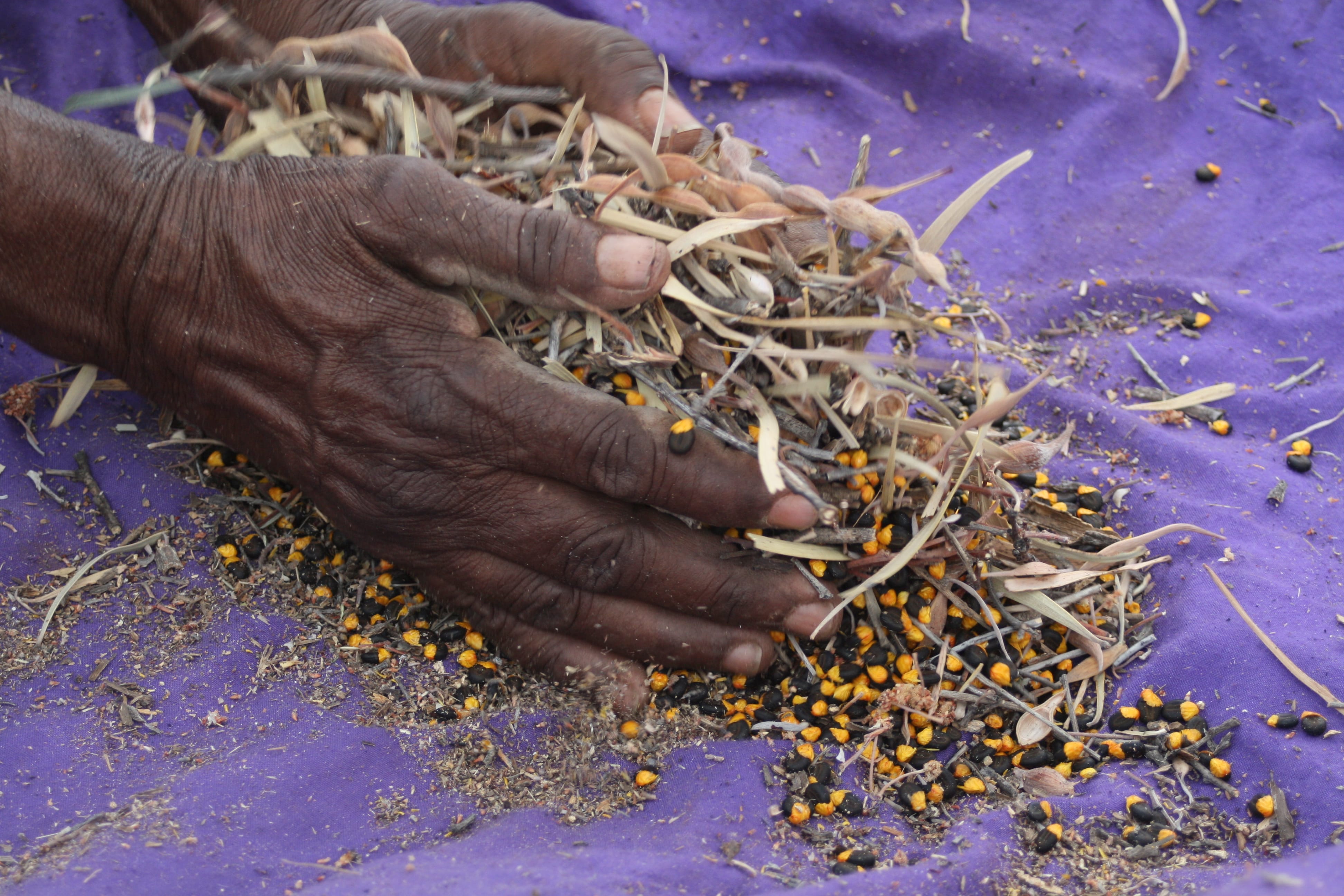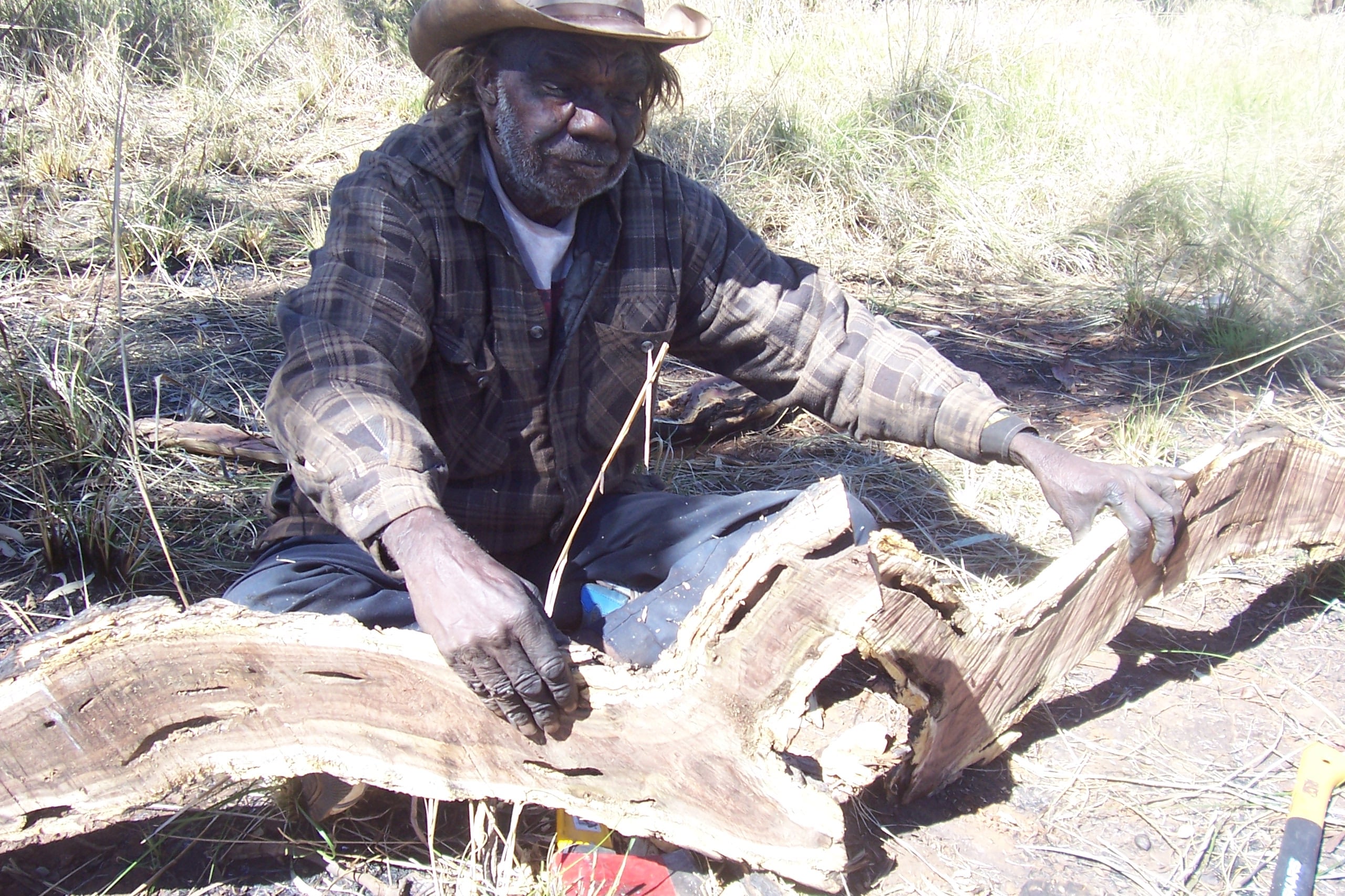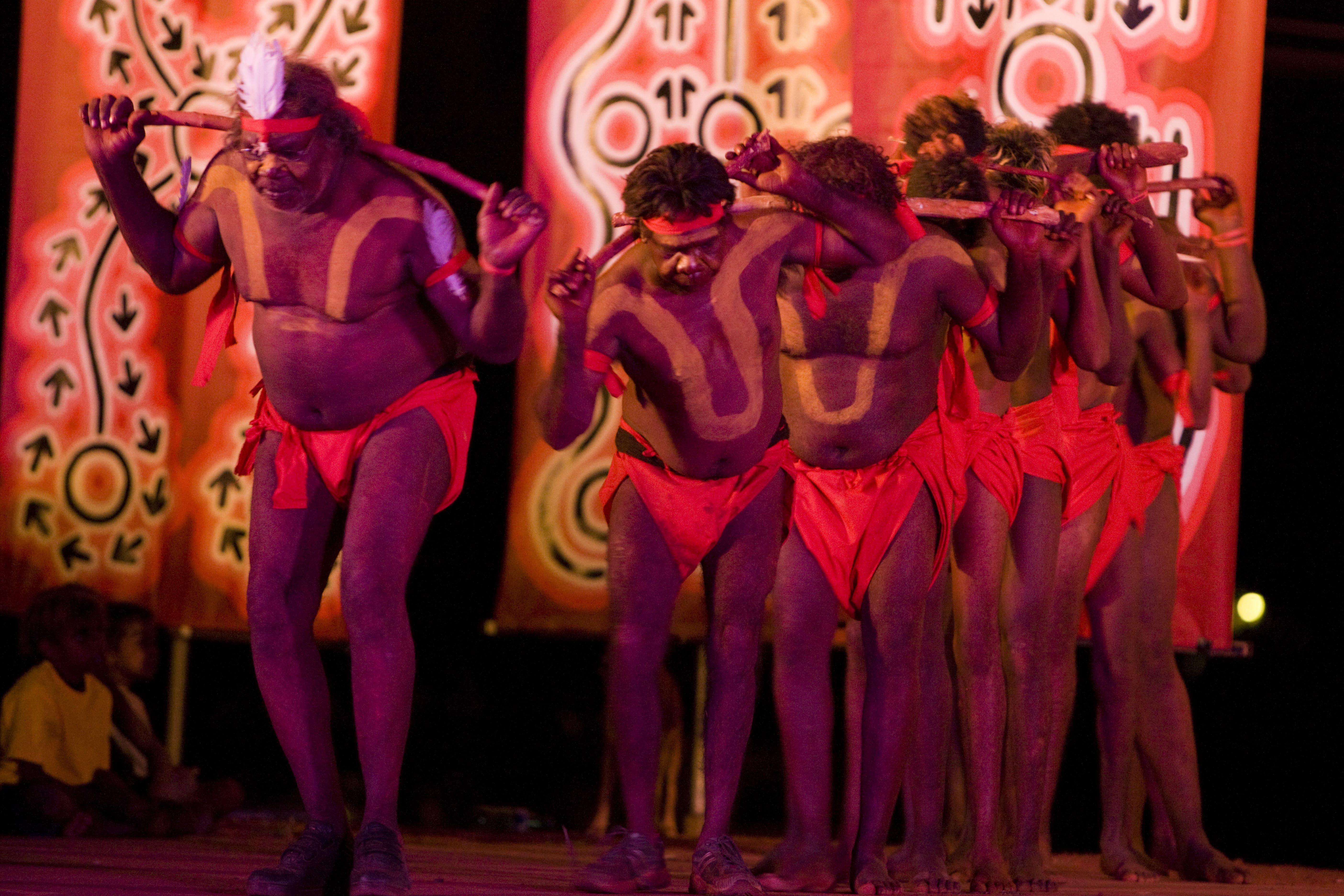Milpirri Banner - WIRNTIKI (Bush Stone Curlew)
Dreaming Design
The arrow shapes are the tracks of the Wirntiki (Bush Stone Curlew) walking, the straight lines represent the white line on the side of the stone curlew’s face. The curved lines at the bottom are yunta or windbreaks (used for blocking the wind when sleeping outside). The three circles are important places that the wirntiki ancestors travelled to such as Mungkururrpa near the Tanami Downs Station Homestead.
Find Mungkururrpa near the Tanami Downs Station Homestead - Map
Belonging to Skin Groups
Jupurrula, Jakamarra, Napurrurla and Nakamarra (Red Group)
Dreaming Story
The Wirntiki (Bush Stone Curlew) is connected with bush beans which are the edible seeds (pirlarla) of Acacia coriacea (wakirlpirri). Wirntiki also had interactions with Warlu jukurrpa, the fire dreaming (See the Warlu Milpirri Banner). The Wirntiki banner belongs to the red group but as the wirntiki ancestors travelled further north towards Ngurunyku (Lake Buck) they changed skin to the Japangardi, Napangardi, Japanangka, and Napanangka (green group) and become the responsibility of a different set of families.
Warlu Kurlangu (fire dreaming) Milpirri Banner - Photo / Information
Find Ngurunyku (Lake Buck) - Map
Drawn By
Tim Jupurrula Kennedy (dec.), or Jacko Jakamarra Gordon (dec), 2005.
Artist Profile
Jacko Gordon Jakamarra: His bush name was Tingiyari Jakamarra. Born near Mongrel Downs station at a place called Rilyka known for Pirlarla (bush bean). His language group was not Warlpiri but rather the Kartangarurru, whose country is around the jump up in the road between Tanami Mine and Lajamanu. His country is Wirnmawarnu. He used to paint Pirlarla, Ngapa and Wintiki Dreamings. He lived at Lajamanu and painted with his two wives, Lizzie and Susan Napaljarri. He was one of the original group of artists at Lajamanu in 1986. Jakamarra was a Ngangkari or spiritual healer; as an elder he was a regular participant in recording cultural knowledge during country visits and sacred site surveys.
Latin Name
Burhinus Grallarius
Biology
Wirntiki (Bush Stone Curlew) - Photo / Information
Hear the sound of the Wirntiki's (Bush Stone Curlew) call - Video
Language Stories
Ngamirliri, kakarda kirrirdiyijala kujaka nyina, parrulkapiya, wurliyaju witalku ka wapa - wuurnpa. Kirrirdipardu wita - ngamirliriji. Ngulaju - puunpuunpa - palkaju yumurruju. Walyawalya-piya yangka. Kala ngari puunpuunpa-nyayirni. Ngamirliriji, kirrirdiyijala ka wapa walyawana, parrulkapiya, parrulka ka wapa walyangka, nyanungu ka wapa walyawanayijala. Ngulajangkaju, paarr-pardimilki ka kankarlu, ngurungkalku ka yani - ngamirliriji. Pirri-manirra ka walyangkayijala ngaka wurnturu. Ngamirliri, ngulaji kirrirdipardu. Nyanungu-piya-kula-jala parrulka-piya, kala jalja-juku karla nyinami. Kutu-kula-jala kala kirrirdi-jiki-jala ka wapamija ngamirliriji. Kirrirdi wirnpiwirnpi. Mirrijilki kirrirdimpayi. Ngamirliriji. Mungarlangurla-jala yika wapa ngamirliriji, kala, kulalpa mungangka wapayarla wardilyka. Ngulaji ka jarda-jala nguna, marnawana parntarri, ngamirliri ka wapami mungangkaju. Ngamirliri ka watiyarla yintirdirla nyina, kulaka yujuku-wanarlangu wapa - nyinami ngamirliri, ngari ka yintirdi-miparla parrangkaju parntarri - kaninjarni yangka. Ngulanya ngamirliriji. Kulakarna pina nyina miyiki ngamirlirikirlanguku, karija ngurrpangka yika ngarni - ngaka mungangka ka wapami.
The Stone Curlew, which also has a long neck, like a bustard, has little feet. They are narrow and a little long and thin. The Stone Curlew is reddish - that is the down on its body. It is the colour of the earth. It is just very reddish-brown. The Stone Curlew walks tall along the ground, like the bustard. The bustard walks on the ground, this one walks along the ground also. Then it takes off, flies up high in the sky. The Stone Curlew then lands somewhere else in the distance, where it then walks around on the ground. The Stone Curlew is tall. It is actually like the Bush Turkey, but a little less than it in size. But the Stone Curlew is actually still tall. It is long and very thin. Its legs are very long. It's at night that the Stone Curlew moves around. But the Bush Turkey doesn't move around at night. It sleeps, crouched in the spinifex grass, while the Stone Curlew walks around at night. The Stone Curlew perches on the stump of a tree, it doesn't move around nests for instance, it just sits, it just perches on a tree-stump during the day - under one.
Kajili yapangku purda-nyanyi ngamirliri wangkanja-kurra: "Kiwirlirli...", ngulaju maliki panu kalu palka nyina. Wita-wita kalu lirri-nyina warnapariji.
If someone hears the Stone Curlews going "kiwirlirli" then there are many dogs around. There are many baby dingoes gathered at that place.
Ngamirliri ka kiwirlirli-kiwirlirli-wangka mungangka. Kajilpa ngamirliri wangkayarla mungangka ngurra-wana kutu, kajilpa ngatinyanurlu purda-nyangkarla jamulu, kajika tururr-ngunamirra-jala kurduju - ngamirliri kajilpa kiwirlirli-kiwirlirli-wangkayarla.
The ngamirliri bird calls out at night going kiwirlirli-kiwirlirli. If it calls out like this at night somewhere near where people are sleeping and if a mother hears it and does nothing about it, then her child might throw a trembling fit - that's if the curlew calls out.
Kaminarlu-wiyi kalarna purranjarla ngarnu ngamirliri kuyu-wangurlarlu.
When I was a young girl I cooked and ate a curlew when we had no (other) meat.
Source: Dictionary Source: Laughren, M., K. L. Hale, and Warlpiri Lexicology Group, 2005 Warlpiri-English Encyclopaedic Dictionary. (Accessed Via Kirrkirr Interface to Electronic Files.) University of Queensland.
Milpirri Dance
In the Milpirri performance, Wampana is danced by the men supported by women. There are two variations: Ngalia side - Wampana men are travelling north carrying a big snake before handing it over to the Warnyaka mob. Warnyaka side - Wampana men are travelling North carrying a big snake that they have received from the Ngalia mob - Video
Further reading
More about the bush Stone Curlew as the harbinger of death - Story


![Wirntiki (Bush Stone Curlew). Copyright free Credit for image: By Dick Daniels (http://carolinabirds.org/) (Own work) [CC BY-SA 3.0 (https://creativecommons.org/licenses/by-sa/3.0) or GFDL (http://www.gnu.org/copyleft/fdl.html)], via Wikimedia Commons.](/sites/default/files/banners/photos/Bush_Stone-curlew_RWD-min.jpg)


